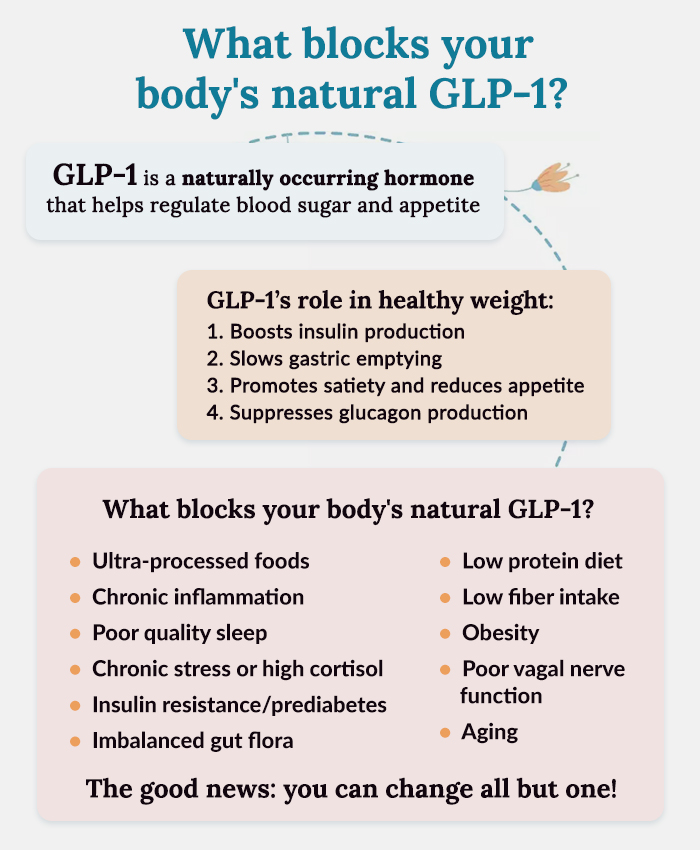Authored by Dr. Sarika Arora, MD
There are plenty of reasons to be skeptical about Ozempic – since 1950, the FDA has withdrawn 25 different weight loss drugs from the market after they were found to cause awful side effects in patients. Why should Ozempic not also disappoint over time?
So today, let’s take a closer look at the research on Ozempic, Wegovy and Rybelsus — as well as natural alternatives — to give you the information you need to make the right decision for you and your health.
What is Ozempic?
Ozempic is the brand name of a medication called semaglutide, which has historically been prescribed to help patients with Type 2 Diabetes regulate their insulin levels. Semaglutide mimics a hormone your body already makes called glucagon-like-peptide-1 (GLP-1).
In fact, every time you eat, your gut releases GLP-1 as a natural response. Among its jobs, GLP-1 helps stimulate insulin production to control blood sugar spikes, regulate digestion and signal to your brain that you’re full – all of which control appetite and metabolism. However, a long list of factors – among them poor sleep, chronic stress and ultra-processed foods – act to suppress your natural GLP-1 production and function, making it harder for your body to regulate weight on its own.
This is where Ozempic comes in. Ozempic and other semaglutide drugs are designed to mimic GLP-1 by sending signals to GLP-1 receptors in the body, increasing insulin production, inhibiting glucagon secretion, slowing the time it takes your body to digest and process food, and artificially tricking your brain into telling your body that it’s full — even though you’re technically in a caloric deficit.
Who is Ozempic for?
Ozempic was approved by the FDA in 2017 for use in patients with Type 2 Diabetes to help regulate their insulin levels. The resulting weight loss that Ozempic patients experienced was a surprising positive side effect, and doctors began prescribing Ozempic to an increasing number of overweight patients without diabetes, a practice known as “off-label use.” Wegovy, a semaglutide medication also manufactured by Novo Nordisk, is FDA-approved to treat obesity. It is available at a slightly higher dosage compared to Ozempic, and is more readily covered by insurance to support weight loss.
Wegovy is usually prescribed to patients with a body mass index (BMI) of 30 or higher, or those with a secondary condition related to obesity, like knee pain or hypertension. In 2022, 40 million people were prescribed semaglutide to treat obesity, diabetes or both.
What about the side effects?
The side effects reported by the 2021 study (which was funded by Ozempic’s manufacturer, Novo Nordisk) included gallbladder-related disorders, acute pancreatitis, gallstones and severe gastrointestinal disorders. “Serious adverse events” were also reported in 9.8% of study participants taking semaglutide. Yet these side effects are relatively innocuous compared to the adverse events self-reported by patients since then.
Adverse events linked to Ozempic
- Gastroparesis, or stomach paralysis, which prevents digestion from occurring by paralyzing the nerves and muscles along the digestive tract
- Kidney failure and acute kidney injury
- Bowel and intestinal obstruction
- Insulin metabolism disruption, including damage to the gut-brain axis
- Thyroid cancer, specifically medullary thyroid carcinoma
- Diarrhea and nausea
- Ileus
- Pancreatitis
- Suicidal thoughts or ideation
- Gastroenteritis
- Muscle loss
- “Ozempic Face”: a new term for Ozempic-induced facial wasting, i.e. that gaunt, instantly aged appearance of patients who lose volume and fat from their faces as a result of the kind of drastic weight loss that Ozempic delivers

- Sarcopenia
- Multiple endocrine neoplasia syndrome type 2
- Diabetic retinopathy
- Hypoglycemia
- Increased heart rate
- Hair loss
- Development of eating disorders, especially given that semaglutide is now authorized for use in children
- Urticaria, a raised or itchy skin rash
- Infertility, increased risk of miscarriage, low birth weight and incidences of visceral (kidney, liver, heart, blood vessels) and skeletal (sternebra, cranial bones, vertebra, ribs) fetal abnormalities were observed
- Hypersensitivity reactions, including anaphylaxis
It’s worth noting that approximately 39% of semaglutide-induced weight loss is actually muscle loss, not fat loss. Medications that act on GLP-1 receptors, such as Ozempic and Wegovy, can negatively impact muscle mass, bone density and resting metabolism. For some patients, side effects (especially stomach paralysis and pancreatitis) did not improve even after stopping semaglutide treatment.
Sadly, the vast majority of patients who lose weight while taking Ozempic or Wegovy report “rebound weight gain” that equals or exceeds the amount of weight they lost. In fact, a 2022 study found that approximately one year after stopping semaglutide treatment, patients had already regained the weight they lost.
Is there a better way? Supporting your body’s own GLP-1
Let’s return to a key point I made earlier: GLP-1 was not invented by a pharmaceutical company. GLP-1 is a natural hormone your body already makes to regulate appetite, blood sugar and metabolism. The problem is that somewhere along the way, your body’s inner regulatory system shifted out of balance and your natural GLP-1 production was disrupted.

When you suppress GLP-1, your body struggles to regulate hunger and fullness signals. This can lead to intense cravings, frequent overeating, blood sugar spikes, insulin resistance – and stubborn weight gain. That’s why semaglutide medications like Ozempic can seem so effective: they override a broken hormone system that could have been out of balance for years. But their effects last only as long as you’re taking the drug. Once you stop, the underlying issues race back to the surface, which is why most people regain all the weight after stopping the drug. You never addressed the root cause.
The real question is: how can we help the body produce more of its own GLP-1, naturally and sustainably? The good news is, we already know how. By supporting your body’s own GLP-1 production, you can finally fix the problem at its source and achieve lasting, healthy weight loss.
Here are some proven ways to do just that:
Eat more protein and fiber.
Eating more protein and fiber-rich foods is a powerful way to naturally boost GLP-1 activity. Excellent sources include beans, salmon, flax and chia seeds, leafy greens, and other fiber-packed foods. Soluble fiber, in particular, promotes satiety and helps reduce cravings between meals – amplifying its benefits. Foods like black beans, sweet potatoes, broccoli, psyllium husk and sunflower seeds provide this beneficial fiber.
Avoid excess sugar and processed foods (which have excess sugar).
Diets high in added sugars can blunt GLP-1 release over time, disrupting gut hormone signaling and contributing to blood sugar spikes that overwhelm the body’s natural appetite regulation. Excess sugar also fuels inflammation and elevates cortisol levels, both of which interfere with GLP-1’s effectiveness. What to eat instead for enhanced GLP-1 activity: skip the sugary processed foods and aim for mostly whole, nutrient-dense foods that help the body maintain steady blood sugar levels.
Prioritize quality sleep.
Sleep plays a vital role in enhancing the body’s natural GLP-1 activity by creating the optimal hormonal and metabolic environment for it to function. During restful sleep:
- Insulin sensitivity improves
- Inflammation and cortisol levels decline
- Gut hormone rhythms – including GLP-1 – are better regulated
- Appetite hormones like leptin and ghrelin are balanced, making the brain more responsive to GLP-1’s appetite-suppressing effects
In essence, quality sleep amplifies GLP-1’s natural ability to support healthy metabolism, reduce cravings and promote satiety.
Resistance training.
Regular moderate exercise improves GLP-1 sensitivity and overall metabolic health. Resistance training (also known as strength training or weight training) is particularly effective. Aim for 2-5 times per week for 30-45 minutes per session.
Chew slowly and eat mindfully.
GLP-1 release depends on communication between your gut and brain. When you eat too quickly, your body misses the chance to send those fullness signals. Use mealtime as a time to unwind and destress. Slow down, enjoy your food and give your GLP-1 the chance to do its work.
Supplements can help too.
Nutrients that support natural GLP-1 activity include:
- Berberine. Nicknamed “Nature’s Ozempic,” the medicinal plant Berberine helps to improve insulin sensitivity, enhance fat burning and modulate gut microbiota for better metabolic efficiency and cholesterol balance.
- Lycopene. Supports healthy lipid metabolism and assists with reducing visceral belly fat.
- Vitamin C. Helps regulate cortisol and oxidative stress, both of which have major negative impacts on GLP-1 when left unchecked.
- Myo/D-Chiro Inositol. Promotes insulin sensitivity and hormonal balance, which is especially beneficial for women already struggling with blood sugar challenges. Inositol also helps reduce cravings and supports steadier energy levels throughout the day. Our Weight BioType #1 combo contains this exact mix of nutrients.
Follow your values
Do you need chemical weight loss medication injections to lose weight? Take a look at the side effects listed above one more time before answering.
And now think about the alternative: when you finally address what’s behind your body’s GLP-1 imbalance, you give yourself a much better chance at lasting, natural weight loss. And you do it in a way that strengthens your body’s own systems – not overrides them.
Here at Women’s Health Network, we believe the most effective approach is one that works with your body’s innate biology. After supporting thousands of women over the past 20 years, we know sustainable weight loss isn’t about crash diets or punishing routines. It’s about learning what your body truly needs, and giving your biology the support to do what it was designed to do.
Whatever path you choose, there is a natural weight loss solution that makes sense for you. We’re here to help you find it.
https://www.nejm.org/doi/10.1056/NEJMoa2032183
https://www.ncbi.nlm.nih.gov/books/NBK581942/
https://www.ncbi.nlm.nih.gov/pmc/articles/PMC3424459/
https://www.today.com/health/how-ozempic-affects-mental-health-rcna72029
https://www.nejm.org/doi/10.1056/NEJMoa2032183
https://honehealth.com/edge/health/ozmepic-muscle-loss/
https://jamanetwork.com/journals/jama/fullarticle/2810542
https://dom-pubs.onlinelibrary.wiley.com/doi/10.1111/dom.14725
https://www.frontiersin.org/articles/10.3389/fnut.2022.1013055/full
https://www.ncbi.nlm.nih.gov/pmc/articles/PMC9182772/












